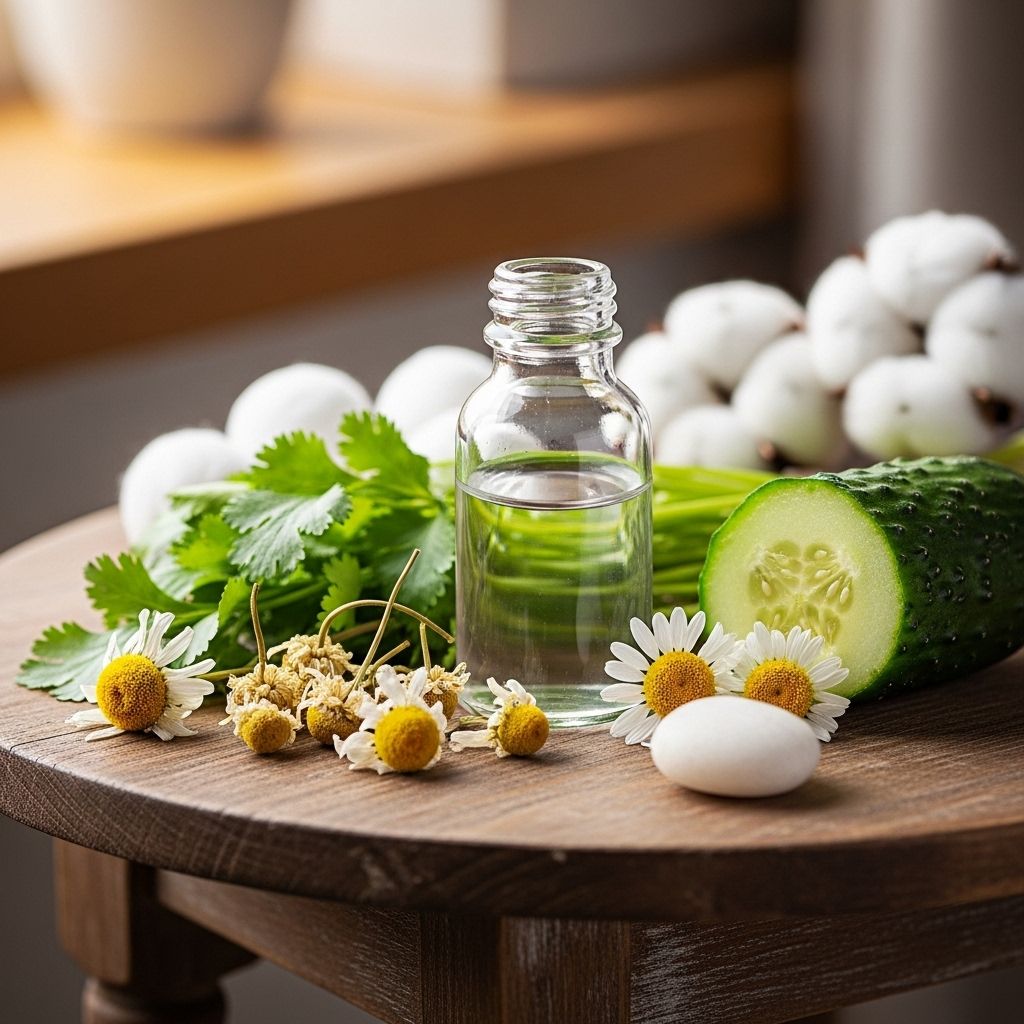Home Remedies for Pink Eye: Natural Relief and Treatment Guide
Natural solutions for soothing pink eye symptoms and promoting healing

Table of Contents
- Understanding Pink Eye and Its Causes
- Immediate Relief Remedies
- Herbal and Natural Treatments
- Nutritional Support for Eye Health
- Essential Hygiene and Prevention Measures
- When to Seek Medical Care
- Frequently Asked Questions
Understanding Pink Eye and Its Causes
Pink eye, medically known as conjunctivitis, is an inflammation of the conjunctiva, the thin, clear membrane that covers the white part of the eye and lines the inside of the eyelids. This common eye condition affects millions of people annually and can cause significant discomfort if left untreated. Understanding the different types of pink eye is crucial for selecting the most appropriate home remedies.
There are three primary types of conjunctivitis: viral, bacterial, and allergic. Viral conjunctivitis is the most common form and typically results from the same viruses that cause the common cold. Bacterial conjunctivitis occurs when harmful bacteria infect the eye, often producing thick, yellow or green discharge. Allergic conjunctivitis develops as a reaction to allergens such as pollen, dust mites, or pet dander, and usually affects both eyes simultaneously.
Common symptoms of pink eye include redness in the white of the eye, increased tear production, thick discharge that may crust over the eyelashes, itching or burning sensations, blurred vision, and increased sensitivity to light. The severity and duration of these symptoms can vary depending on the underlying cause and individual factors.
Immediate Relief Remedies
Cold and Warm Compresses
Compresses are among the most effective and accessible home remedies for pink eye relief. The choice between cold and warm compresses depends on the type of conjunctivitis you’re experiencing. For bacterial or viral pink eye, warm compresses are typically more beneficial as they help increase blood circulation, reduce inflammation, and promote drainage of any discharge.
To create a warm compress, soak a clean washcloth in warm water, wring out excess moisture, and gently place it over closed eyelids for 5-10 minutes. Repeat this process several times daily, ensuring you use a fresh, clean washcloth each time to prevent reinfection. The warmth helps soothe discomfort and may help clear blocked tear ducts.
For allergic conjunctivitis, cold compresses are more effective as they help reduce swelling and provide immediate relief from itching and burning sensations. Wrap ice cubes in a clean cloth or use a cold, damp washcloth, applying it gently to closed eyelids for 5-10 minutes at a time.
Artificial Tears and Eye Drops
Over-the-counter artificial tears can provide significant relief by lubricating the eyes and washing away irritants and allergens. These preservative-free drops help maintain moisture levels in the eyes and can be used frequently throughout the day as needed. When selecting artificial tears, choose preservative-free options to avoid additional irritation, especially if you need to use them multiple times daily.
For allergic conjunctivitis, antihistamine eye drops may provide additional relief by blocking the histamine response that causes itching and inflammation. However, it’s essential to choose drops specifically designed for allergic reactions and follow the manufacturer’s instructions carefully.
Herbal and Natural Treatments
Chamomile Tea Compresses
Chamomile has been used for centuries as a natural anti-inflammatory and soothing agent. German chamomile, in particular, contains compounds that may help reduce inflammation and provide antimicrobial benefits. To prepare a chamomile compress, steep two chamomile tea bags in hot water for 5 minutes, allow them to cool to room temperature, and then place them over closed eyelids for 10-15 minutes.
The anti-inflammatory properties of chamomile can help reduce redness and swelling while providing a soothing, cooling sensation. However, individuals with ragweed allergies should exercise caution when using chamomile, as it may trigger allergic reactions in sensitive individuals.
Green Tea Treatment
Green tea contains powerful antioxidants, including epigallocatechin gallate (EGCG), which possess anti-inflammatory and antimicrobial properties. These compounds may help reduce inflammation and support the healing process. Brew a green tea bag in hot water, allow it to cool completely, and then place the cooled tea bag over closed eyelids for 10-15 minutes.
The antioxidants in green tea may help combat free radicals that contribute to inflammation while providing a gentle, soothing effect on irritated tissues. Additionally, the natural tannins in green tea may help tighten tissues and reduce swelling.
Calendula and Eyebright
Calendula, also known as marigold, has traditionally been used for its healing and anti-inflammatory properties. While scientific evidence is limited, some people find relief using calendula-infused water as a gentle eye wash or compress. Similarly, eyebright has been historically used for eye conditions, though its effectiveness requires further scientific validation.
When considering these herbal remedies, it’s crucial to use only preparations specifically intended for ocular use and to discontinue use if any irritation occurs. Always consult with a healthcare provider before trying herbal treatments, especially if you have known allergies or sensitivities.
Apple Cider Vinegar Solution
Apple cider vinegar contains acetic acid, which may possess antimicrobial properties that could help combat bacterial infections. To create a diluted solution, mix one tablespoon of apple cider vinegar with one cup of clean water. Using a clean cloth, gently apply this solution around the affected eye area, being extremely careful to avoid direct contact with the eye itself.
This remedy should be used with extreme caution, as undiluted apple cider vinegar can cause severe irritation and damage to sensitive eye tissues. Never apply apple cider vinegar directly to the eye, and discontinue use if any stinging, burning, or increased irritation occurs.
Nutritional Support for Eye Health
Essential Vitamins and Minerals
Proper nutrition plays a vital role in supporting eye health and may help accelerate recovery from conjunctivitis. Vitamin A is particularly important for maintaining healthy epithelial tissues, including those in the eyes. Foods rich in vitamin A include carrots, sweet potatoes, spinach, and liver. Beta-carotene, a precursor to vitamin A found in orange and dark leafy vegetables, can also support eye health.
Zinc is another essential mineral that supports immune function and wound healing. Foods high in zinc include oysters, beef, pumpkin seeds, and chickpeas. Adequate zinc levels may help the body fight off infections more effectively and promote faster healing of inflamed tissues.
Omega-3 Fatty Acids
Omega-3 fatty acids, particularly EPA and DHA found in fish oil, possess anti-inflammatory properties that may help reduce inflammation associated with conjunctivitis. These essential fats support overall eye health and may help maintain proper tear film composition. Good dietary sources include fatty fish like salmon, mackerel, and sardines, as well as flaxseeds, chia seeds, and walnuts.
Consider incorporating omega-3 rich foods into your diet during recovery, or consult with a healthcare provider about appropriate supplementation if your diet lacks these essential nutrients.
Probiotics and Immune Support
A healthy gut microbiome supports overall immune function, which may help the body fight off infections more effectively. Probiotic-rich foods such as yogurt, kefir, sauerkraut, and kimchi can help maintain beneficial bacteria levels in the digestive system.
Additionally, staying well-hydrated by drinking plenty of water helps maintain proper tear production and supports the body’s natural healing processes. Aim for at least 8 glasses of water daily, and consider increasing intake if you’re experiencing fever or other symptoms that may contribute to dehydration.
Essential Hygiene and Prevention Measures
Proper Hand Hygiene
Maintaining excellent hand hygiene is perhaps the most critical aspect of managing pink eye and preventing its spread. Wash your hands thoroughly with soap and warm water for at least 20 seconds, especially before and after touching your eyes or applying treatments. Use alcohol-based hand sanitizer when soap and water aren’t available.
Avoid touching or rubbing your eyes, as this can worsen irritation and spread the infection to the other eye or to other people. If you must touch your eye area, ensure your hands are thoroughly clean and use a clean tissue or cotton pad instead of your fingers when possible.
Environmental Cleanliness
Regular cleaning of your environment can help prevent reinfection and reduce exposure to irritants. Change your pillowcase daily during the acute phase of conjunctivitis, and wash bedding in hot water to eliminate any bacteria or viruses. Clean your glasses frequently with appropriate lens cleaners, and avoid sharing personal items such as towels, washcloths, or eye makeup.
If you wear contact lenses, discontinue use until the infection completely resolves. Dispose of any contact lenses, solution, and cases that were used during the infection period, as they may harbor bacteria or viruses that could cause reinfection.
Makeup and Eye Care Products
Avoid wearing eye makeup during conjunctivitis episodes, as cosmetics can harbor bacteria and may further irritate already inflamed tissues. Once the infection resolves, replace all eye makeup products, including mascara, eyeliner, and eyeshadow, as they may be contaminated.
Similarly, replace any eye care products such as eye creams or serums that may have been contaminated during the infection period. This precautionary measure helps prevent reinfection and ensures optimal healing.
When to Seek Medical Care
While many cases of pink eye can be managed effectively with home remedies, certain symptoms warrant immediate medical attention. Seek professional care if you experience severe eye pain, significant vision changes, increased light sensitivity, or symptoms that worsen after 24-48 hours of home treatment.
Additional red flags include thick, colored discharge (especially green or yellow), fever accompanying eye symptoms, or if you have a compromised immune system. Newborns and infants with pink eye symptoms should always receive prompt medical evaluation, as they may be at higher risk for complications.
Bacterial conjunctivitis often requires antibiotic treatment to prevent complications and reduce the duration of symptoms. A healthcare provider can determine the underlying cause of your conjunctivitis and prescribe appropriate treatment if necessary.
Frequently Asked Questions
Q: How long does pink eye typically last with home remedies?
A: Viral conjunctivitis usually resolves within 7-14 days with proper home care, while bacterial conjunctivitis may persist longer without antibiotic treatment. Allergic conjunctivitis often improves quickly once the allergen is removed or antihistamines are used.
Q: Can I use honey as a home remedy for pink eye?
A: While honey has antimicrobial properties, it’s not recommended for eye use due to the risk of contamination and potential for severe allergic reactions. Stick to proven remedies like compresses and artificial tears.
Q: Is pink eye always contagious?
A: Viral and bacterial conjunctivitis are highly contagious, while allergic conjunctivitis is not contagious. You’re most contagious during the first few days of symptoms or while discharge is present.
Q: Can I go to work or school with pink eye?
A: It’s best to stay home during the acute phase of viral or bacterial conjunctivitis, typically for 24-48 hours after starting treatment or until discharge stops. Follow your workplace or school’s specific policies regarding contagious conditions.
Q: Are there any home remedies I should avoid?
A: Avoid using breast milk, urine, or undiluted essential oils in or around the eyes. Also avoid sharing eye drops, using expired medications, or applying anything directly to the eyeball without proper dilution and medical guidance.
Q: Can pink eye lead to serious complications?
A: While most cases resolve without complications, untreated bacterial conjunctivitis can occasionally lead to more serious infections. Seek medical care if symptoms worsen or don’t improve with home treatment within a few days.
References
- https://nweyeclinic.com/7-effective-home-remedies-for-pink-eye-relief/
- https://www.ebsco.com/research-starters/complementary-and-alternative-medicine/natural-treatments-conjunctivitis
- https://www.bmhsc.org/blog/relief-in-sight-home-remedies-for-pink-eye
- https://www.mayoclinic.org/diseases-conditions/pink-eye/diagnosis-treatment/drc-20376360
- https://www.webmd.com/eye-health/pinkeye-home-care
- https://nyulangone.org/conditions/conjunctivitis/treatments/home-treatments-for-conjunctivitis
- https://www.cdc.gov/conjunctivitis/treatment/index.html
- https://www.nyoph.com/blog/easy-home-remedies-for-pink-eye/
- https://my.clevelandclinic.org/health/diseases/pink-eye-conjunctivitis
Read full bio of medha deb












